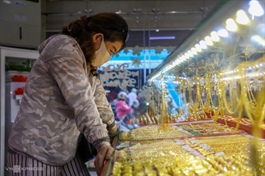Coffee exporters squeezed with rising expenditures
Coffee exporters squeezed with rising expenditures
Coffee exporters are enjoying little benefit from current high prices as freight costs and other factors impact their overall operations.
Following the recent loosening of pandemic regulations, Intimex My Phuoc JSC is preparing its coffee products for export to traditional markets like Europe, Japan, and the US.
Nguyen Duc Hiep, deputy director of Intimex – the third-largest Vietnamese coffee exporter – told VIR, “Coffee prices are around $2,100 per tonne on the international trading floor, up $600-800 per tonne compared to the same period last year. We are pleased with these upbeat prices at the London floor, which offsets the high increase of ocean freight.”
In the first nine months of this year, Intimex exported 90,000 tonnes of coffee with a value of $150 million.
“We made profits with our coffee; however, the benefits of that are not that high because of the ocean freight hikes,” Hiep said.
Costs for transporting freight by sea from Vietnam to overseas, especially to the United States and the European Union, have reported a 7-8-fold increase on-year. To date, this problem has yet to be resolved despite numerous meetings between Vietnamese authorities and foreign ocean carriers. “Foreign ocean carriers are in a position to control freight charges,” Hiep said.
Statistics published by the Import-Export Department under the Ministry of Industry and Trade show that in September, Vietnam exported 120,000 tonnes of coffee with a total value of $245 million, up 7.4 per cent in quantity and 9 per cent in value on month. The accumulated figures for the first nine months show that 1.2 million tonnes of coffee worth $2.25 billion were exported, a decrease of 4.2 per cent in quantity and up 4.4 per cent in value on-year.
The most important export markets are the US, Europe, Russia, Japan, and China. Among these, Europe is Vietnam’s largest market, accounting for 33.8 per cent of total export volume and 58.9 per cent of total export turnover.
In early September, coffee prices hovered around a near 4-year high, following cues from international markets, while harvest was coming to an end in some parts of Indonesia.
Farmers in the Central Highlands, Vietnam’s largest coffee-growing area, sold their coffee at $1.80 per kg, the highest level since November 2017.
According to business analyst Vietnam Credit, as of May, the three largest coffee exporters in Vietnam were Vinh Hiep Co., Ltd., Intimex Group JSC, and Intimex My Phuoc JSC.
The average export turnover of Vinh Hiep amounts to 50,000-70,000 tonnes per year. Meanwhile, Intimex Group JSC owns 11 factories that process high-quality coffee for export with an annual capacity of 570,000 tonnes.
Closing 2021 with the market’s volatility, exporters forecast that their activities will rebound from 2022 when the restrictions are gradually removed and international trade is reopened.
Thai Nhu Hiep, director of Vinh Hiep Co., Ltd. – the company that exported the first batch of coffee to Belgium and Germany under the trade agreement with the EU – told VIR, “More restrictions could soon be lifted, so disruptions to Vietnam’s coffee exports are likely short-lived, and the demand of customers may rebound by the second quarter next year.”
He added that the volatility of coffee on international trade floors is not dependent on the demand and supply of the market. “It is rather the result of global fears over shortages, especially when Vietnam was under months-long lockdowns, combined with the increase on the selling price of oil,” Hiep said.
Ocean freight costs had been impacting export profits. “We have to accept exporting with little profit, sometimes even with losses, to ensure our credibility with foreign partners. However, we expect that the chaos will be controlled soon,” he added.
A report by Fitch Solutions shows that Brazil’s coffee production should also bounce back fairly quickly, provided adverse weather does not return.
That means the global coffee supply could rebound in the 2022/2023 season, with the average annual price for arabica forecast to decline to $1.20 per pound in 2023. “Ongoing government support schemes will support production in Latin American and Asian nations, including Colombia and Vietnam,” projected Fitch Solutions.
“At the same time, growth in consumption seems to be peaking in many of the major key consumers, such as the EU and Japan,” the report notes.
Amid the pandemic, manufacturers and exporters have been trying to maintain operations, even expanding wherever possible.
Recently, Nestlé Vietnam announced an additional investment of $132 million to double its processing capacity of high-quality coffee lines at its Tri An factory in Dong Nai province.
The factory is one of Nestlé’s largest plants in Vietnam and also one of the group’s most modern coffee processing plants in the region. With a view to producing high-quality coffee, the products made at the Tri An factory are exported to more than 25 countries around the world, including markets like Europe, Japan, South Korea, the US, and Australia.
The new investment in this plant will help Nestlé Vietnam produce a wide range of products. With advanced production lines, equipment, and technology, Nestlé hopes to improve the value of Vietnamese agricultural products.
























